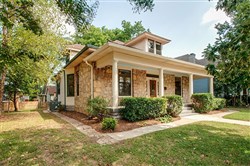VOL. 43 | NO. 45 | Friday, November 8, 2019
Lack of affordable housing pushing families with kids out

1303 Ordway
Nashville’s schools are often denigrated for their shortcomings when test scores are released each year. State scores are not good, either, Tennessee placing anywhere from 36th to 43rd nationally, depending on the source.
Things seem to be improving, once again depending on the source. Some charter schools outperform some public schools, while some public schools fare better than some charter schools. There are times when some Metro schools test better than some Williamson County schools, although Williamson County is renowned for its public education system.
Recently, a member of Mayor John Cooper’s new administration said he feels Metro taxes are considerably lower than cities of the same size. In attendance was David Ewing, the CEO of Nashville History on Tour, who is one of the premier historians on the subject of Davidson County.
Ewing said one of the reasons for a lower tax base is there has been no reason to expand the physical school system. In 1971, he explained, there were 92,000 students enrolled in Metro schools. That was the first year of busing in Davidson County.
This year there are 86,000 students enrolled in Metro Nashville Public Schools.
Despite the city growing by more than 200,000 in overall population, the enrollment in grades K-12 has dropped by 6,000 students during the past 50 years. Additionally, Ewing noted, Metro public kindergarten enrollment is 25% Latino. Without the growth of the Latino community, the numbers would be even less.
During the early days of busing, private schools appeared across suburbia. Many of those remain and are scurrying to expand their physical plants in order to meet the demand. There is rarely a private school without a capital campaign of some sort in the works.
On the positive side, most of the development of the institutions that educate the citizenry is with private funds. On the negative side, what is being done for the 86,000?
Ewing says 80% of the 86,000 are on free or reduced lunch programs. If that is accurate, only 17,200 students in Nashville public schools pay for their lunch. That cannot be a healthy economic model for long-term real estate growth.
Where will they live? How can the city sustain itself under this situation?
There was a moratorium on the construction of residential housing in the downtown area beginning in the 1960s and extending into this century, and it was during this time that the suburbs flourished. As residential downtown development has exploded, it seems to have lured more short-term rentals, second homes, nests for empty nesters and millennials, many of whom are childless.
Consequently, there are no students being zoned for urban schools migrating into the downtown area. Yet, the infrastructure of the city is in tatters and a tax hike looms. It may not be this year or the next, but it has to happen.
What will happen to Nashville’s growth in the short term when the tax increase hits? My prediction is that it will not be affected.
Traffic here is better than many places, taxes are lower and will remain lower, even with an increase. There also is no income tax.
We need to get used to growth. It’s not abating anytime soon.
Subsequently, there will be no affordable housing for the parents of the children on the free or reduced lunch plans. Eventually, if nothing is done for them, the outlook is grim.
Sale of the Week
The Lockeland Springs area in East Nashville has always fared well in the real estate world, and the house at 1303 Ordway is an example of the strength of the market. It also demonstrates there is a cap that buyers will pay.
The house was originally listed for $825,000 but sold for $40,000 less at $785,000. Although the property was only on the market for 24 days when it went under contract, the writing was on the wall – perhaps all of the walls – that the house had been priced too high.
The listing Realtor and the seller knew they were pushing the limit. But in a wild real estate environment, there is no definitive price.
In the current record-setting real estate arena, the first week on the market is equivalent of 30 days on the market in the past. And if there is no offer in the first 10 days, it’s overpriced. Listing broker Lynne Robertson of Compass RE has years of experience and had a wise seller who understand that the $785,000 price was a good one.
So many times, sellers rebuff sound offers early in the listing only later to lament those decisions, often asking the listing brokers to try to locate the people who made the original offers. In most cases, the buyers have bought. If not, they will smell blood and distress and make an even lower offer than they had previously.
Nicholas Lane Woodard of Benchmark Realty fame represented the buyer in the transaction. With 3,126 square feet in the main house and an additional 500 square feet in a garage studio, the house sold for a respectable $216 per square foot or $251 per square foot if the studio footage is deducted.
The house has a new electrical system and a 7-year-old roof over the three bedrooms, two full baths and a half bathroom.
Richard Courtney is a licensed real estate broker with Fridrich and Clark Realty and can be reached at [email protected].